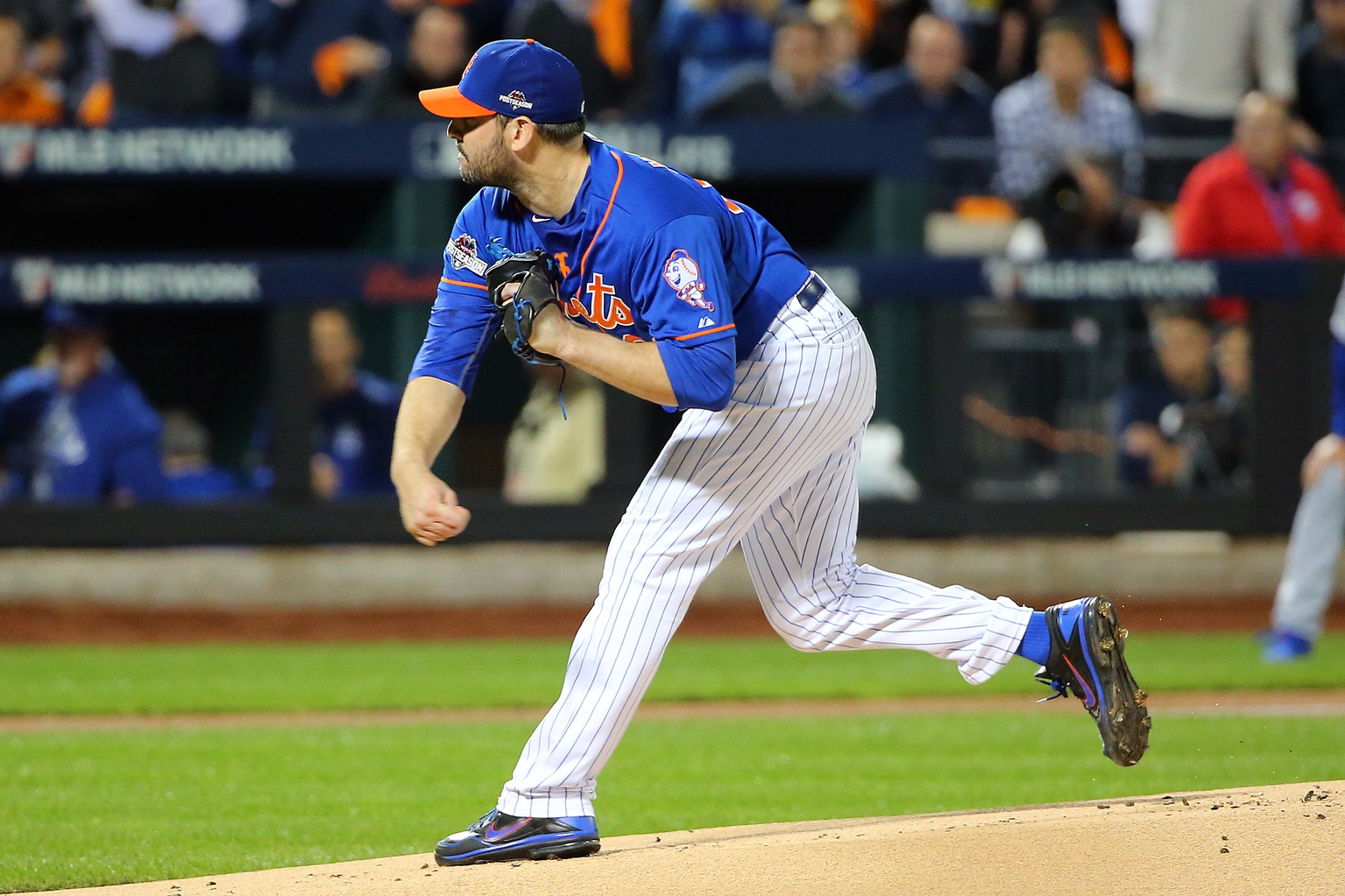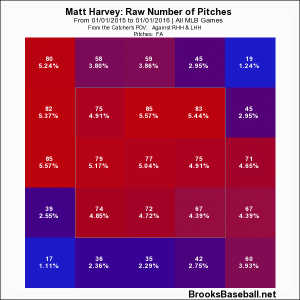In 2015, Matt Harvey has been a magnet for controversy and fodder for baseball Twitter’s #HotTake machine. At the risk of piling on, I can bite my tongue no longer: Harvey throws a lot of four-seam fastballs. There. I said it. And you know what? I have no regrets.
Harvey, like Michael Wacha in the division series, goes with his four-seam fastball about 55 percent of all pitches (in September, 51.62 percent to left-handed batters and 56.39 percent to right-handed batters). Unlike, Wacha, though, batters have slugged only .370 against the pitch in September (.388 overall, including the postseason).
On the season, Harvey’s secondary pitches against right-handed batters were a slider (20.84 percent) and curve (10.24 percent), as he likes to stay low and away. Opposing righties struggled with both, not hitting a single home run on either pitch:
| Pitch | SLP | HR |
| Slider | .169 | 0 |
| Curve | .205 | 0 |
Against left-handed batters, his secondary pitches have been a change (16.11 percent) and curve (15.14 percent), staying away, but up in the zone. Against which batters had success:
| Pitch | SLP | HR |
| Change | .470 | 3 |
| Curve | .468 | 4 |
The Cubs have left-handed hitters like Anthony Rizzo, Kyle Schwarber, and Chris Coghlan who do a solid job protecting the outer half of the plate and up.
Make no mistake, though, the Cubs will see four-seam fastballs. In just one start this season has Harvey thrown a pitch with greater frequency than his four-seam fastball: April 19th against the Miami Marlins, when he threw 43 sinkers to just 11 fourseam fastballs. After that start, Harvey threw just 31 sinkers combined in his next 14 starts.
Last week, we detailed the Cubs success against four-seam fastballs from right-handed pitchers. Of the eight likely starting position players in Game One, five had at least five home runs and .451 slugging percentage.
Also unlike with Wacha, the Cubs hitters do not have that same-division familiarity with Harvey. As can be expected, Harvey’s numbers against right-handed batters and left-handed batters are both very good, but left-handed batters did have some solid power numbers this season:
| BB%` | K% | OPS | ISO | HR | |
| RHB | 2.9% | 24.3% | .544 | .084 | 3 |
| LHB | 7.0% | 25.5% | .676 | .162 | 15 |
Expect Coghlan and Schwarber in the starting lineup. In addition, to their overall success against right-handed pitchers, both Coghlan (.658 SLG) and Schwarber (.607 SLG) were outstanding against changeups from right handers. A top of the lineup of the switch-hitting Dexter Fowler, followed by lefties Schwarber, Rizzo, and Coghlan, in some order, seems like the team’s best approach against Harvey.
The Importance of the First Pitch: What the Cubs Can Learn from the NLDS against John Lackey
Not to overstate its importance, but the first of pitch of at-bats could decide the game. In 2015, the difference in Harvey ahead 1-and-0 and behind 0-and-1 was stark:
| BB%` | K% | OPS | ISO | HR | |
| After 0-1 | 3.6% | 33.7% | .464 | .082 | 6 |
| After 1-0 | 9.2% | 20.5% | .771 | .178 | 8 |
This season, Harvey went with his four-seam fastball 60 percent of first pitches against left-handed batters and right-handed batters. And as you can see below, Harvey lives over the plate with his first-pitch, four-seam fastballs:
Does this favor the Cubs?
If a batter is taking all the way, it is a free strike for Harvey, who can then expand his strike zone with his slider and curve away against right-handed batters, and his change and curve buried inside to left-handed batters. However, in our Wacha scouting piece, we mentioned the Cubs swung at 69.4 percent of pitches in the strike zone, the second-highest average in the NL. For a team that ranked second in walk rate (9.1 percent) and fifth in OBP (.321), the Cubs hack when the pitch is over the plate, even when it it is the first pitch of the at-bat.
And when the Cubs swung at the first pitch, they did considerable damage, slashing .385/.389/.671, and posting the best OPS in all of baseball (1.060) by 29 percentage points. The team swung at 10.8 percent of first pitches, and hit 22.8 percent of their home runs (39 of 171) when doing so. The 39 home runs were the second most in baseball.
Harvey is scarce with his pitches, finishing with the eighth-lowest pitches per inning (14.8) and ninth-fewest pitches per plate appearance (3.71) in the NL. He doesn’t waste pitches, and likes to his use fastball around the plate on the first pitch to get ahead. When Harvey gets ahead, he is dominant. Where have the Cubs hitters seen that recently?
John Lackey threw even fewer pitches this season, tossing the second fewest pitches per inning and third fewest pitches per plate appearance, respectively. In Game One against Lackey, the Cubs swung at 7 of 25 first pitches (28 percent), and did not record a hit. In Game Four, the Cubs swung at 8 of 13 first pitches (61.5 percent), and picked up all four of their runs off him with two consecutive first pitch swings by Jason Hammel and Javier Baez.
With runners in scoring position, Harvey’s first pitch becomes even more predictable, as his four-seam fastball rate jumps to 70 percent.
Will the Cubs jump on first-pitch fastballs from a pitcher who lives over the plate? It could be the smart approach, consider their season-long success on first pitches, including Game Four of the NLDS, and Harvey’s relative predictability early in the count.
Will the curve be a factor?
In Harvey’s start against the Cubs on May 13th, he threw 19.4 percent curves (19 of 98 pitches), his second-highest curve frequency of the season. With the pitch, he generated eight whiffs, and the Cubs put just two balls in play, not recording any hits.
The Cubs did very little against curves from right-handed pitchers, and did basically nothing with two strikes. Below is the production, or lack thereof, from potential Game One starters:
| Player | Curve (SLP/HR) | Curve w/ 2 strikes (SLP/HR) |
| Fowler | .184/0 | .177/0 |
| Schwarber | .150/0 | .167/0 |
| Coghlan | .140/0 | .039/0 |
| Ross | .000/0 | .000/0 |
| Rizzo | .460/2 | .250/1 |
| Baez | .143/0 | .000/0 |
| Castro | .511/2 | .269/0 |
| Soler | .192/0 | .105/0 |
| Jackson | .214/20 | .375/1 |
Rizzo and Castro had success, slugging at least .460, but the other players could not crack the .200 slugging percentage barrier. If the Cubs fall behind, either by taking strikes or not putting the ball in play, look for Harvey to go with the curve above his 12.76 percent usage rate in the regular season.
Saturday night’s alright for swinging…
Harvey, when he is right, is as good a pitcher as there is in baseball. He averaged less than six innings per start in his last eight outings, but he has been dominant while in the game. He is a tough matchup for any roster. The Cubs, though, might have the skill set
Harvey’s strength is his four-seam fastball. The Cubs strength is hammering four-seam fastballs from right-handed pitchers. In September and October, Harvey is still averaging 95.88 mph with his four-seam fastball, but despite maintaining velocity, will he consistently challenge a great fastball-hitting team? Additionally, Harvey needs to be around the plate early in the count to be successful, and the Cubs are the best team in baseball on the first pitch.
The Cubs should be aggressive early in the count, when Harvey will likely be coming with fastballs, especially with runners of base. This approach paid huge dividends against Lackey. Hoping to work deep counts against Harvey seems like a foolhardy approach, as Harvey’s ability to get ahead and expand the strike zone with his three secondary pitches make him dominant. If he does get ahead, right handers should look inside with breaking pitches, and left handers should look away with breaking and offspeed pitches. The Cubs, both righties and lefties, remain extremely vulnerable to the curve from right-handed pitchers.
The Cubs offense has a tough task on Saturday night, but there is a path to success. If the hitters fall behind early in counts, though, it could be a long six or seven innings for them. And if I might close with a final controversial statement regarding Harvey: Game One should be a great matchup.
Lead photo courtesy of Anthony Gruppuso-USA TODAY Sports


Makes ya think